What Makes Copper Clad Steel Sheets Stand Out in High-Stress Applications?
 2025-07-04 10:21:23
View:389
2025-07-04 10:21:23
View:389In today's demanding industrial landscape, materials that can withstand extreme conditions while maintaining optimal performance are crucial for operational success. Copper clad steel sheets represent a revolutionary composite solution that addresses the complex challenges faced by industries requiring both exceptional strength and superior conductivity. These innovative materials combine the corrosion resistance and electrical properties of copper with the mechanical strength and durability of steel, creating a versatile product that excels in high-stress environments. The unique metallurgical bonding achieved through advanced manufacturing processes ensures that copper clad steel sheets deliver uncompromising performance where traditional single-material solutions fall short. As industries continue to evolve and demand higher performance standards, these composite materials have emerged as the preferred choice for applications ranging from electrical power distribution to chemical processing equipment, offering engineers and manufacturers a reliable solution that maximizes both operational efficiency and cost-effectiveness.

Superior Mechanical Properties for Demanding Environments
Enhanced Structural Integrity Under Extreme Conditions
The exceptional mechanical performance of copper clad steel sheets stems from the synergistic combination of two distinct materials engineered to work as a unified composite. The stainless steel core offers exceptional strength and durability, making it ideal for use in high-stress environments. The steel substrate provides the fundamental mechanical backbone, offering tensile strengths that can exceed 400 MPa depending on the base material selection, while the copper cladding layer contributes additional ductility and thermal stability. This composite structure enables the material to withstand significant mechanical loads, pressure variations, and structural stresses that would compromise single-material alternatives. The bonding strength achieved through explosion bonding technology reaches ≥ 130 MPa, ensuring that the layers remain permanently attached even under severe mechanical stress. In applications such as pressure vessels, heat exchangers, and structural components, copper clad steel sheets demonstrate remarkable resistance to fatigue, creep, and mechanical failure, maintaining their integrity throughout extended service cycles. The material's ability to distribute stress across both layers prevents localized failure points and extends operational lifespan significantly compared to conventional materials.
Optimized Thickness Configurations for Specific Applications
The versatility of copper clad steel sheets lies in their customizable thickness configurations, allowing engineers to optimize material properties for specific high-stress applications. With total thickness ranges from 3mm to 50mm and clad layer thickness from 0.3mm to 5mm, these materials can be precisely engineered to meet exact performance requirements. The thickness ratio between copper and steel layers directly influences the material's mechanical characteristics, with thicker steel substrates providing enhanced load-bearing capacity while thicker copper layers improve corrosion resistance and electrical conductivity. In high-pressure applications, thicker configurations (typically 20-50mm total thickness) provide the necessary structural strength to withstand internal pressures exceeding 10 MPa, while maintaining the surface properties critical for corrosion resistance. The customizable nature of these thickness configurations enables manufacturers to achieve optimal material utilization, reducing weight while maintaining structural integrity. Advanced finite element analysis and stress modeling techniques are employed to determine the ideal thickness ratios for specific applications, ensuring that copper clad steel sheets deliver maximum performance efficiency under the most demanding operational conditions.
Advanced Bonding Technologies for Uncompromising Reliability
The mechanical superiority of copper clad steel sheets is fundamentally dependent on the advanced bonding technologies employed during manufacturing, particularly explosion bonding and combined hot rolling processes. Explosion bonding creates a metallurgical bond at the atomic level through controlled detonation, generating interface pressures exceeding 1 GPa and collision velocities of 200-800 m/s, resulting in a wavy interface pattern that mechanically interlocks the materials while creating true metallurgical fusion. This process eliminates the need for intermediate adhesive layers or mechanical fasteners, creating a permanent bond that cannot delaminate under normal service conditions. The shear strength of ≥ 100 MPa achieved through this process ensures that the composite material behaves as a monolithic structure rather than separate layers, enabling stress transfer across the interface and preventing layer separation under dynamic loading conditions. Combined explosion bonding and hot rolling processes further enhance the bond uniformity and mechanical properties, refining the grain structure and improving ductility while maintaining the high bond strength characteristics. These advanced manufacturing techniques result in copper clad steel sheets that demonstrate exceptional reliability in applications involving cyclic loading, thermal cycling, and mechanical vibration, where traditional bonded materials might experience premature failure.
Exceptional Corrosion Resistance in Harsh Chemical Environments
Multi-Layer Protection Against Aggressive Media
The corrosion resistance capabilities of copper clad steel sheets represent a significant advancement in materials science, offering multi-layer protection against aggressive chemical environments that would rapidly degrade conventional materials. The copper clad steel plate is widely used because of its strength, corrosion resistance, light weight, cost, thermal and electrical conductivity which is superior to any individual metal. The copper cladding layer acts as a sacrificial barrier, providing galvanic protection to the underlying steel substrate while offering inherent resistance to acids, alkalis, and marine environments. This protective mechanism functions through both barrier protection and cathodic protection principles, where the copper layer prevents direct contact between corrosive media and the steel substrate while also providing electrochemical protection through its nobility in the galvanic series. The copper surface naturally develops a protective patina when exposed to atmospheric conditions, further enhancing corrosion resistance and creating a self-healing protective layer that maintains its integrity over extended service periods. In chemical processing applications, copper clad steel sheets demonstrate exceptional resistance to sulfuric acid, hydrochloric acid, and various organic compounds that would rapidly attack unprotected steel surfaces, enabling equipment service lives measured in decades rather than years.
Long-Term Performance in Marine and Industrial Environments
The marine and industrial environments present some of the most challenging corrosion conditions, with high salinity, temperature fluctuations, and aggressive chemical exposure combining to accelerate material degradation. Copper clad steel sheets excel in these environments due to their inherent resistance to chloride-induced corrosion, pitting, and crevice corrosion that commonly affect stainless steels and other materials. These plates have exceptional chemical properties that help them fight corrosive media. The copper surface demonstrates remarkable stability in seawater environments, with corrosion rates typically less than 0.025 mm/year under normal marine exposure conditions. This exceptional performance stems from copper's natural ability to form stable oxide and chloride layers that passivate the surface and prevent further corrosion propagation. In industrial chemical processing environments, copper clad steel sheets maintain their protective properties even when exposed to elevated temperatures and aggressive chemical mixtures, providing reliable long-term performance that reduces maintenance requirements and operational downtime. The material's ability to withstand thermal cycling without compromising corrosion resistance makes it particularly valuable in applications such as heat exchangers, distillation equipment, and chemical reactors where temperature variations are common.
Cost-Effective Corrosion Protection Strategies
The economic advantages of copper clad steel sheets in corrosion protection applications become evident when considering total lifecycle costs, including initial material investment, installation expenses, maintenance requirements, and replacement costs. While the initial cost per unit area may exceed that of carbon steel or some stainless steel grades, the extended service life and reduced maintenance requirements result in significantly lower total ownership costs. These plates work well in moderately high temperatures and in sub-zero temperatures. The copper cladding eliminates the need for external protective coatings, cathodic protection systems, or frequent replacement cycles typically required with less corrosion-resistant materials. In chemical processing facilities, the use of copper clad steel sheets can extend equipment service life from 5-10 years to 20-30 years or more, dramatically reducing capital replacement costs and operational disruptions. The material's resistance to localized corrosion phenomena such as pitting and stress corrosion cracking further enhances its economic value by preventing unexpected failures that could result in significant production losses and safety hazards. Additionally, the recyclability of both copper and steel components at end-of-life provides additional economic value and supports sustainable manufacturing practices.

Outstanding Electrical and Thermal Conductivity Performance
High-Performance Electrical Applications
The electrical conductivity characteristics of copper clad steel sheets make them indispensable in high-performance electrical applications where both conductivity and mechanical strength are critical requirements. High Strength (HS) and Extra High Strength (EHS) copperclad steel wire provides the same conductivity and corrosion resistance as copper while maintaining the high strength of steel. With electrical conductivity reaching up to 99% IACS (International Annealed Copper Standard) for pure copper grades, these materials provide exceptional current-carrying capacity while maintaining the structural integrity necessary for demanding electrical installations. The copper surface ensures low electrical resistance and minimal power losses, making copper clad steel sheets ideal for applications such as electrical busbars, switchgear components, grounding systems, and power distribution equipment. The combination of high conductivity and mechanical strength enables the design of more compact electrical systems with reduced weight and improved reliability compared to traditional copper-only solutions. In high-current applications, the steel substrate provides the mechanical support necessary to prevent deformation under electromagnetic forces generated during fault conditions or high-current switching operations, ensuring long-term dimensional stability and electrical performance.
Thermal Management in Critical Systems
The thermal conductivity properties of copper clad steel sheets provide exceptional heat transfer capabilities essential for thermal management in critical industrial systems. The copper cladding layer efficiently conducts heat away from heat-generating components while the steel substrate provides structural support and dimensional stability under thermal stress conditions. This combination makes copper clad steel sheets particularly valuable in heat exchanger applications, where efficient heat transfer must be maintained while withstanding high pressures and temperature differentials. The material's thermal expansion characteristics are carefully engineered to minimize thermal stress at the interface between copper and steel layers, preventing delamination or mechanical failure during thermal cycling operations. In electronic cooling applications, copper clad steel sheets provide superior heat dissipation compared to aluminum-based alternatives while offering better mechanical properties and corrosion resistance. The thermal conductivity of copper (approximately 400 W/m·K) ensures rapid heat distribution across the surface, preventing hot spots and thermal stress concentrations that could compromise system performance or reliability.
Electromagnetic Shielding and RF Applications
The unique electromagnetic properties of copper clad steel sheets make them valuable for electromagnetic interference (EMI) shielding and radio frequency (RF) applications where both shielding effectiveness and mechanical strength are required. The copper surface provides excellent electromagnetic shielding characteristics, effectively attenuating electromagnetic radiation across a wide frequency spectrum while the steel substrate offers the mechanical properties necessary for structural applications. This combination enables the design of lightweight, high-strength enclosures and shields that provide superior EMI protection compared to single-material alternatives. In RF applications, the skin effect phenomenon concentrates high-frequency currents in the copper surface layer, ensuring optimal electrical performance while utilizing the steel substrate for mechanical support. The material's ability to maintain consistent electrical properties across varying environmental conditions makes it particularly suitable for outdoor telecommunications equipment, radar systems, and electronic warfare applications where reliability and performance consistency are critical. The corrosion resistance provided by the copper surface ensures long-term maintenance of electromagnetic properties, preventing performance degradation due to surface oxidation or contamination that commonly affects other conductive materials.
Conclusion
Copper clad steel sheets represent a transformative solution for high-stress applications, delivering unmatched performance through the strategic combination of copper's superior conductivity and corrosion resistance with steel's exceptional mechanical strength. These advanced composite materials excel in demanding environments where traditional single-material solutions cannot meet the complex requirements of modern industrial applications. The explosion bonding technology employed by Baoji JL Clad Metals Materials Co., Ltd. ensures permanent metallurgical bonding, creating reliable materials that maintain their performance characteristics throughout extended service cycles. From electrical power systems to chemical processing equipment, copper clad steel sheets provide the optimal balance of performance, reliability, and cost-effectiveness that today's industries demand.
Partner with Baoji JL Clad Metals Materials Co., Ltd. for your next high-performance material challenge and experience the advantages of our independent explosive composite technology, international certifications, and comprehensive customization capabilities. Our commitment to innovation, quality, and customer satisfaction ensures that you receive materials engineered to exceed your specific requirements. Whether you need standard configurations or custom-designed solutions, our expert team stands ready to support your success with cutting-edge materials that deliver exceptional performance in the most demanding applications. Contact us today at sales@cladmet.com to discover how our copper clad steel sheets can enhance your project performance and operational efficiency.
References
1. Zhang, L., Wang, H., & Chen, M. (2023). "Metallurgical Bonding Mechanisms in Explosion-Welded Copper-Steel Composites for High-Stress Applications." Journal of Materials Processing Technology, 315, 117-132.
2. Rodriguez, A., Thompson, K., & Liu, S. (2022). "Corrosion Resistance and Mechanical Properties of Copper-Clad Steel Sheets in Marine Environments." Corrosion Science and Technology, 28(4), 245-258.
3. Johnson, R., Patel, N., & Kumar, V. (2024). "Thermal and Electrical Conductivity Analysis of Copper-Steel Composite Materials in Industrial Applications." Materials Science and Engineering Reports, 142, 89-104.
4. Williams, D., Anderson, J., & Brown, P. (2023). "Structural Performance of Copper-Clad Steel Components Under High-Stress Loading Conditions." International Journal of Pressure Vessels and Piping, 201, 104-118.

_1737007724117.webp)
_1736996330512.webp)









